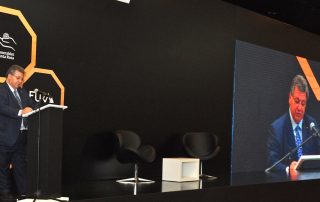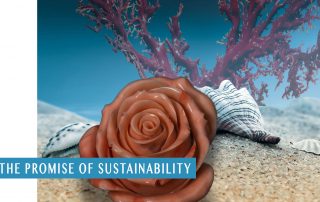-

 CIBJO President calls for the creation of government-monitored chokepoints, to verify integrity of coloured gemstones entering chain of distribution Gallery
CIBJO President calls for the creation of government-monitored chokepoints, to verify integrity of coloured gemstones entering chain of distribution GalleryCIBJO President calls for the creation of government-monitored chokepoints, to verify integrity of coloured gemstones entering chain of distribution
CIBJO President calls for the creation of government-monitored chokepoints, to verify integrity of coloured gemstones entering chain of distribution
ABOVE: Dr. Gaetano Cavalieri, CIBJO President, addressing the World Emerald Symposium in Bogotá on October 12.
October 12, 2018
CIBJO President Gaetano Cavalieri has called for the creation of government monitored chokepoints for the coloured gemstone sector, at which it will be possible to verify the integrity of merchandise accessing the chain of distribution, similar to national Kimberley Process Authorities that verify the identity of rough diamonds entering the global pipeline. He was speaking at the opening of the World Emerald Symposium, which started in Bogotá today, and will precede the start of 2018 CIBJO Congress on October 15.
While regulators to date have focused their attention on diamonds and precious metals, the period of grace for coloured gemstones is coming to an end, Dr. Cavalieri said. “We have to meet the challenge. And we need to do to that without threatening the livelihoods of the men and women who have earned their living over the years from the coloured gemstone trade,” he stated.
“Given the wide variety of coloured gemstones and the massive number of small companies involved in their production and distribution, it is unlikely in the foreseeable future that a single regulatory umbrella body will be established for the coloured gemstone sector, like the Kimberley Process. But if the trade and government cooperate, on a country by country basis, it may be possible to establish a multitude of chokepoints, which can verify and certify the integrity of the gemstones in their respective regions of jurisdiction,” Dr. Cavalieri continued.
“The incentive for governments to join with industry in creating such national chokepoints would be to defend and grow the market share of their own gemstone industries,” he stated. “But that is not the only incentive. It is also a system that will help create legal pathways for artisanal miners, enabling them to enter the legitimate chain of distribution. As we know, today much of the material they produce is sold on the black market or smuggled, and therefore produces little to no tax revenue for the state and local governments.”
Dr. Cavalieri revealed that he has spoken with a number of governments, and the ideas that he presented have been quite well received. He added that a general Responsible Sourcing Guidance document will be presented at the upcoming CIBJO Congress, which in time could come to serve as a set of standards for a future network of national offices, verifying the integrity of coloured gemstones mined in their territories.
To download a full copy of Dr. Cavalieri’s address to the World Emerald Symposium, PLEASE CLICK HERE.
CIBJO Congress 2018 set to kick off in Bogotá on October 15, agendas and related documentation now online
October 10, 2018
With the 2018 CIBJO Congress set to open in Bogotá, Colombia, in five days’ time, agendas and related documentation for the various sessions and meetings that will take place during the event are now available online. Contained in a Digital Binder, they can be downloaded from the dedicated congress website. To download the Digital Binder, please CLICK HERE.
The schedule of the CIBJO Congress includes a series of meetings of different working groups, called sectors and commissions, each of which focuses on a different sector or field of interest in the jewellery industry. The Digital Binder includes the agendas and documentation related to each of their sessions, as well as those sessions that encompass the entire CIBJO membership.
The congress venue will be the Grand Hyatt Bogotá, situated in the heart of Ciudad Empresarial Sarmiento Angulo, in the city’s commercial district, from October 15 to October 17, with pre-congress meetings starting on October 12. Between October 11 and October 14, the World Emerald Symposium will take place at the same venue.
Serving as the official venue for the meeting of the CIBJO Assembly of Delegates, the CIBJO Congress gathers the members of national jewellery and gemstone associations from more than 40 countries and representatives of many of the industry’s most important commercial bodies. During the event, the organisation’s Diamond, Coloured Stones, Pearl, Coral, Precious Metals and Gemmological Blue Books, which are industry’s most widely accepted directories of uniform grading standards and nomenclature, are discussed and updated.
The congress is being hosted by Fedesmeraldas, the National Federation of Emeralds of Colombia, and CDTEC, Colombia’s leading gemmological institute.
CIBJO releases Coral Commission Special Report, looks at research into sustaining and repopulating precious coral reefs
October 3, 2018
With fewer than two weeks to go to the opening of the 2018 CIBJO Congress in Bogotá, Colombia, on October 15, 2018, the eighth and the final of the CIBJO commissions’ Special Reports has been released. Prepared by the CIBJO Coral Commission, headed by Vincenzo Liverino, the report looks at a variety of topics related to precious coral reef sustainability, including government regulation of harvesting, research into methods for repopulating depleted areas, the use of DNA and Blockchain in achieving traceability, and online education.
“The industry encourages the enforcement of the current regulations and, as more scientific data on existing [precious coral] populations becomes available, hopes that harvesting and conservation practices be adapted so that resources are better managed, which is in the best interest of not only the ecosystem, but also the trade,” writes Mr. Liverino.
The special report highlights a number of research projects currently underway in Japan and Monte Carlo, where precious coral samples are being grown under controlled conditions in the laboratory, and in certain cases then transplanted on the seabed.
At a project on Birou island, off the coast of Japan, being conducted by the Precious Coral Protection and Development Association and the Kuroshio Biological Research Foundation, 223 small Corallium japonicum branches were first grown in tanks under controlled conditions and eventually attached to reef-growing blocks positioned underwater at depths of 100 metres. “With the transplanting phase now completed, growth rates are being monitored and other data collected. An encouraging growth rate was recorded both before and after transplantation, and there is a remarkable survival rate of 99 percent,” Mr. Liverino writes.
At the upcoming CIBJO Congress in Bogotá, an online course prepared by the Coral Commission will be presented. Catering to retailers selling precious coral jewellery, it covers a range of topics, including the history and cultural relevance of precious coral in many parts of the world, a layperson’s review of the biology and taxonomy of coral, information about geographic occurrences, accepted trade names for each species, treatments and imitations, CITES and fishing regulations, sustainability concerns, product-care recommendations and a list of scientific references.
“It is hoped that the online course syllabus could become a model and primary reference for gemmological and jewellery schools creating their own educational materials,” Mr. Liverino notes. “They too have a primary role to play in raising the general awareness about precious coral and the sustainability of harvested gem materials within the trade.”
To download a full copy of the CIBJO Coral Commission’s special report, PLEASE CLICK HERE.



